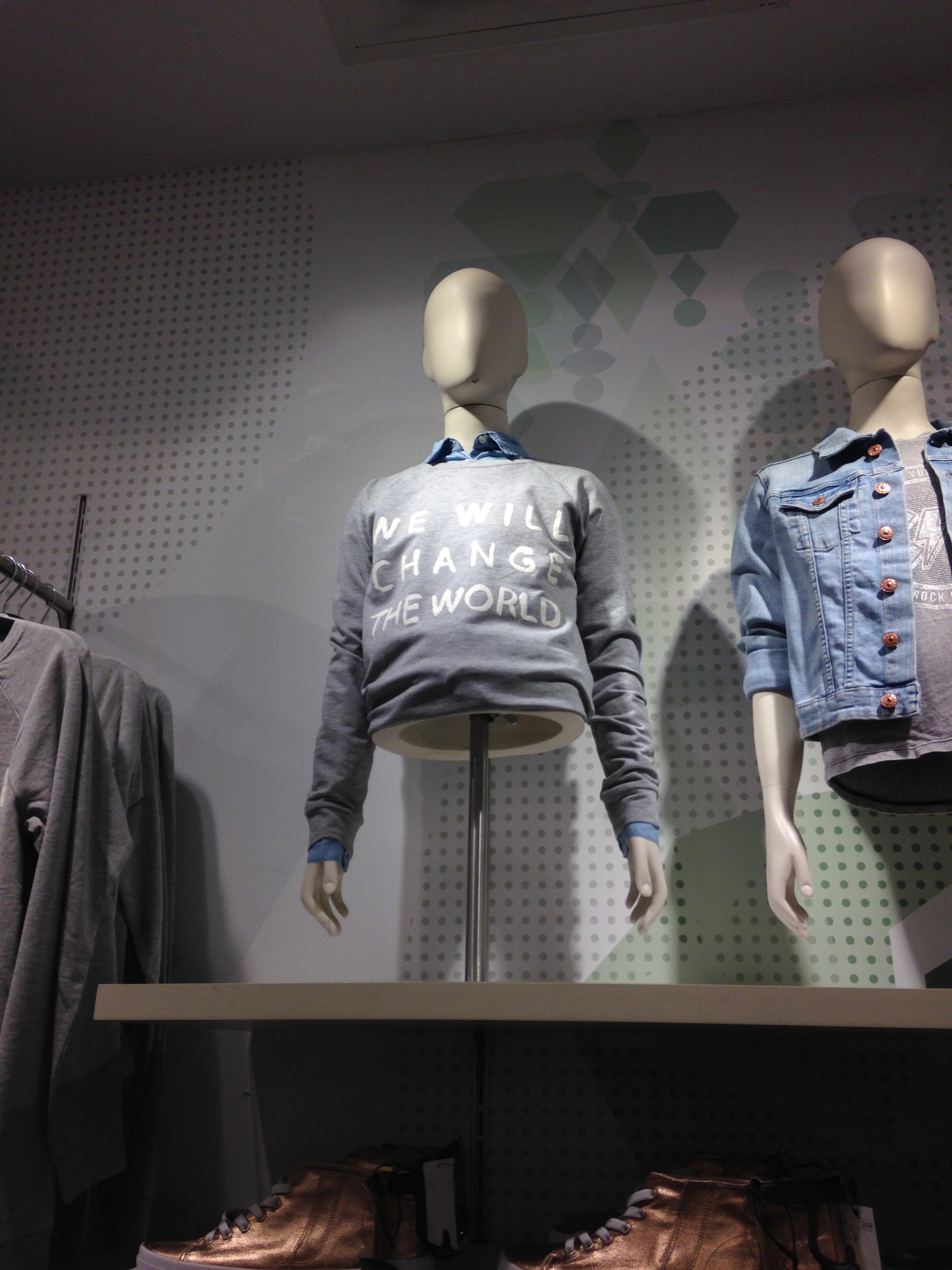Feminist Fashion Trend
This photo was taken April 9th in the children’s section of the H&M store in Richmond Center. A mannequin in the girl’s section is dressed in the sweatshirt with a slogan “we will change the world”. H&M is among the six brands owned and operated by H&M Group. Founded in Sweden in 1947, H&M is a leading fast-fashion brand, with 3962 brick-and-mortar stores in 62 countries and digital markets available in 32 countries (H&M Brand, 2017).
Among the trends featured on the runways during Fashion Weeks in February were statement t-shirts with feminist slogans. New York Fashion Week saw the meshing of feminist activism with fashion. Designers, such as Prabal Gurung and Alice + Olivia used their runways to show resistance against the platforms of the current political policies with regards to women’s sexual health (Hua, 2017). For the end of his show, Gurung dressed his models in simple white t-shirts with different slogans. “The Future is Female”, “Femininity with a Bite” and “We Will Not Be Silenced” are among the 19 different slogan t-shirts featured on the runway and are currently for sale on his website for $195. Outside his show, social media influencers and models marched and posed collectively styling Gurung’s statement tees with other luxury items. H&M markets itself as a trendy yet affordable and sustainable brand and was quick to jump on the feminist fashion trend.
Even though Gurung ventured outside the traditional look of the model to incorporate women of color, racialized women, queer women and men, and plus size women as his political fashion ambassadors, the hefty price tag of his clothing makes it inaccessible to the public. The fusion of feminism and fashion could be considered an example of the commodification of social issues. MacDonald and other transnational and intersectional feminists regard “enacting ethics through consumption” as affective economy (2016, p.7). While the individuals may wish to wear their hearts on their sleeves to take a stand for their beliefs, Macdonald argues that while the implications may be positive on the local level, it further steers away from the structural inequalities at a global level, instead “into a question of individual (consumer) morality” (2016, p. 7).
The movement of feminist fashion from the adult apparel industry into children’s wear is highlighted in the image. Western culture sees the girl as hope for the positive development of her community, and source of empowerment for future generations. The slogan “we will change the world” has several social implications relating to social differentiation. First, by using the girl as a symbol of future feminism reflects the western idea of childhood as universal (MacDonald, 2016, p. 10). MacDonald writes that the body of the “girl-child is motivated as a site for intervention because of her assumed female vulnerability” (2016, p. 10). The use of the collective “we” is especially problematic. From an intersectional and transnational feminist lens, we can see that that collective “we” is a homogenization of the female experience, devoid of unique social locations such as sexuality, race, abilities, culture, religion and colonial implications. The idea of “changing the world” already implies an imaged future that needs to be intervened, particularly for oppressed women (MacDonald, 2016, p. 13). Using Edward Said’s paradigm for orientalism, we can conclude that that if we do no adopt more intersectional and transnational thinking, we, as the middle class Western straight female, will continue to use feminism to our benefit to make assumptions of the other as a project to be rescued and converted to our standards, therefore socially differentiating ourselves as moral, modern and civilized.
As consumers, we need be critical and aware of the ethics and implication of political fashion. Whether it’s a $200 Prabal Gurung feminist tee or a $20 empowering sweatshirt from H&M, we cannot forget that fashion is closely tied to the political economy and that the production chain itself may be exploiting the very same women and girls that western culture so desperately wants to save. While it’s acceptable to participate in the political fashion trend, one should not use his/her support for commodities as rescue aids that contribute to more silencing of the voices and experiences of others.
Work Cited
H&M Brand. (2017). Retrieved from https://about.hm.com/en/brands/hm.html
H&M Foundation. (2017). Retrieved from http://hmfoundation.com/
Hua, K. (2017, February 17). Designers Who Made Political Statements At New York Fashion Week 2017. Retrieved from https://www.forbes.com/sites/karenhua/2017/02/17/designers-who-made-political- statements-at-new-york-fashion-week-2017/#31dce2f128b5
MacDonald, K. (2016). Calls for educating girls in the Third World: futurity, girls and the ‘Third World Woman’. Gender, Place & Culture, 23:1, 1-17, DOI: 10.1080/0966369X.2014.991699
